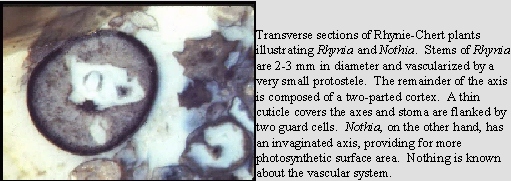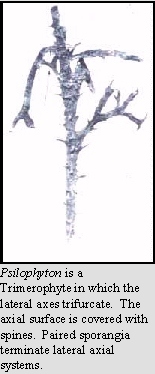

Early Silurian to Devonian thalloid plants characterized by pseudoparenchymatous (false parenchyma) tissue comprised of filaments, surrounded by a thick cuticle. Some produce thick-walled spores. Those colonizing soils may have been the first tier on the landscape.
Prototaxites (Late Silurian to Late Devonian) - "Trunks" up to 1 m wide and 2 m long. Internal structure of large (13-35 Ám) and small tubes (5.3 Ám in diameter) that may branch. Some small tubes may exhibit vesicle-like swellings. Thick walls of large tubes contain anastomosing filamentous components. Thin walls consist of a septum with a complex pore. Thirteen species represented by compression-impressions & permineralizations. Affinities with the Fungi (F. Hueber, pers. comm.)

Pachytheca - (Late Silurian to Early Devonian) Algae consisting of single spherical body 1.5-5 mm diameter composed of an inner and outer zone. The inner zone consists of multicellular filaments oriented randomly, but in the outer zone are radially oriented.
Parka - (Early Devonian) A dorsiventral thallus, circular to ovoid up to 5 cm, with clustered spores. The thallus is cellular, upper and lower epidermis with parenchyma, and attached by a ventral holdfast. Spores appear cuticularized, 28-34 m in diameter, interpreted to be in a sporangium at the surface.
Spongiophyton (Middle Devonian) - Remains have been recovered from fluvial sediments, indicating their terrestrial origin. Thalloid branching plant thought to have a habit similar to modern liverworts (Gensel et al., 1991) that is typically preserved as a cuticular sheath with a porate (200-300 micrometer raised areas with holes) and non-porate surface. Porate cuticle 3X as thick as non-porate surface. No evidence of vascularization. Recently, Stein et al., (1993) have suggested that these plants are lichens.
Earliest vascular plants in the Late Silurian (Pridolian; 414-408) are assigned to the Order RHYNIALES (RHYNIOPHYTES). Basic characteristics of the group include:

These rhizomatous plants are the first group to grow upwards towards the light, with a determinate growth habit to the aerial parts of the organism. Many "stands" are found consisting of only one type of plant in the area. This is indicative of a colonizing, pioneering (r-strategist) behavior.
Cooksonia - Small plant attaining heights of 10 cm, dichotomous branched with globose terminal sporangia. Found in monotypic stands.
Rhynia - Attaining heights of 18-50 cm, attached to rhizomatous axes with monopodial branching (one half of the dichotomy becomes physically dominant), terminal sporangium fusiform. Found either in monotypic stands or integrated with other rhyniophytalean/zosterophytalean plants.
Nothia - Naked invaginated axes with pear-shaped sporangia (apical dehiscence) on adaxially (downward) recurved stalks. Sporangia may be helical or whorled in arrangement. Found with other rhyniophytes.
Renalia - Longest axis recorded is 11 cm, dichotomous, with round to reniform (kidney-shaped) terminal sporangia. Pseudomonopodial in growth habit of monotypic stands. Displays characteristics of both Rhyniophytes and Zosterophyllophytes.
A silicified Devonian peat bog known as the Rhynie Chert is one locality in which many of the earliest vascular plants were first identified. The official Rhynie Chert homepage can give you up-to-date information on research focused on this Fossil Lagerstätten!
Zosterophyllum - Dichotomously branched aerial axes with peculiar (infrequent) laterl branches that result in an H-shaped bauplan (body architecture). Cauline sporangia are clustered near the top of the axes. Commonly found as monotypic assemblages.
Sawdonia - Aerial parts up to 30 cm tall (may have attained heights of 0.5 m), pseudomonopodial (anatomically the axes appear dichotomous, but the plant takes on the appearance of a central axis with laterals) from rhizome with lateral dichotomous axes. Apices are coiled (circinate or fiddle-heads such as found in ferns). Lateral spines have no vascular tissue. Reniform (kidney-shaped) sporangia are loosely aggregated into spikes. Commonly found in monotypic assemblages.
Gosslingia - Aerial stems up to 0.5 m in height with dichotomous branching but a strong centralized axis resulting in an imperfect pseudomonopodial habit. Small short vascularized branches (<2 mm long) occur along the axis. Commonly found as monotypic assemblages
Rebuchia - Plant of densely branched, tufted aspect with distinct upright axes up to 15 cm in height. Some dichotomous axes terminated by dense clusters of stalked, opposite to subopposite sporangia.

Trimerophyton - Lateral branches originate in a spiral pattern from an erect stem. Lateral branches trifurcate (branch three times) close to the main axis, and continue to divide apically. Each branch ends with two terminal third-order branches upon which are two pendant sporangia. No leaves are known; estimate of height not available.
Psilophyton - Variable branching of the erect stem (pseudomonopodial, dichotomous or trichotomous) that emerged from rhizomatous mat. Stem with variously shaped spines. Paired sporangia terminate ultimate dichotomy of the lateral branches; homosporous. Central axis may be as much as 3.5 cm in diameter; maximum height may have been > 1m.
Pertica - Lateral branches are tetrastichous (four branches in an opposite pattern), forming a clockwise spiral, and originate from a main axis Individual branches dichotomize many times at right angles to each other. Axes have small bumps (papillae). Clusters of sporangia (32-256) terminate branches; trilete spores are homosporous. Main axis 1.5 cm in diameter; maximum height may have been several meters.
Two clades of lycopsids are recognized - Eligulates and Ligulates. These can be separated by the presence of a small flap of tissue, the ligule, within a modified area on the adaxial surface of the leaf.

Asteroxylon attained a height of 0.5 meters and consisted of erect monopodial branches originating from a flat-lying (prostrate) rhizome. The xylem cylinder is an actinostele (star-shaped). Axes are covered with "enations" (appear to be leaves but lack vascular tissue) with stomata. Kidney-shaped sporangia (reniform) are borne in the axil of an enation. Vascular tissue has been identified in the sporangial area.
Upright and prostrate axes of Drepanophycus (Siegennian-Frasnian) are up to 4 cm in diameter, bearing stout leaves (vascular tissue is present) that may appear thorn-like to curved. The axes may dichotomize infrequently, although some forms have a complex K- or H-branching pattern. These plants possess kidney-shaped sporangia and may have attained heights of several meters.
Protolepidodendron was a herbaceous plant with axes that may be up to 6 mm in diameter (maximum height 30 cm); these are covered with helically-arranged leaves. The leaves fork either once (two tips) toward the distal end. Oval to kidney-shaped sporangia occur on the (adaxial) upper surface of sporophylls.
Colpodexylon is a larger plant, with axes attaining 2.5 cm in diameter and a length of 60 cm. Leaves are helically arranged and three-forked. Sporophylls bear an adaxial, elliptical sporangium.
Leclercqia
, originating in the Emsian and widely dispersed in the Middle Devonian, had axes that may be as large as 7 mm in diameter and up to 50 cm in length (estimated height 1 m). Leaves are helically arranged and densely packed; leaves apices are five-parted. Stomates are found both on the leaves and stems. Fertile leaves bear an adaxial sporangium, and these are intermixed with sterile leaves along the upright axes. Spores are trilete; homosporous.
Most of the Early Devonian plants are small in stature, and vegetation was not stratified initially. Tiering of these plant communities began with the appearance of pseudomonopodial and monopodial growth habits, the result of a change in growth and development of the growing meristem. The earliest body fossils of unequivocal terrestrial arthropods have been isolated from the same locality as the earliest vascular plants (Cooksonia) of Pridoli-age. Edwards (1996) has suggested that the decomposer/microherbivore/predator soil and litter communities identified in the Lower and Middle Devonian extend back at least into the Silurian. There is evidence for terrestrial plant-animal interaction in the Lower Devonian and this is based upon spore-dominated coprolites believed to have been produced by litter-feeding myriapods.
These early plant clades existed into the Middle Devonian where newly evolved plants were larger in size and more complex in architecture. Although the earliest landscapes may have appeared vegetationally homogenous, Raymond et al. (1985) have identified three major phytogeographic regions: